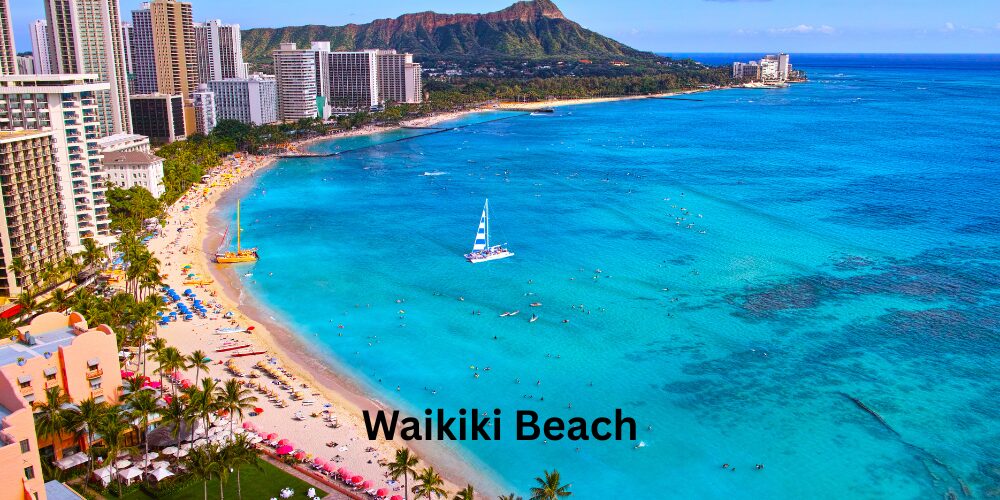Waikiki Beach: Where Dreams are born in the Ocean.
Waikiki Beach is more than a destination—it’s a legend. Fringed by swaying palms, kissed by golden sunlight, and washed by the warm waters of the Pacific, Waikiki is where tropical dreams take shape. Set against the iconic backdrop of Diamond Head, this stretch of sand in Honolulu, Hawaii has long captured the imagination of surfers, sunseekers, royals, and travelers from all over the globe. It’s a place where ancient Hawaiian history blends effortlessly with modern-day luxury, where the spirit of aloha is woven into every wave, lei, and sunset.
From its humble beginnings as a swampy retreat for Hawaiian royalty to its transformation into a global vacation hotspot, Waikiki Beach remains a symbol of Hawaii’s enduring magic.

A Beach with Royal Roots
Long before the high-rises and surf schools, Waikiki was a quiet coastal plain dotted with taro fields and fishponds. Its name in Hawaiian—“wai kīkī”—means “spouting freshwater,” a reference to the streams and springs that once flowed from the nearby valleys.
In the 1800s, Waikiki became a favored retreat for Hawaiian royalty. The aliʻi (chiefs) would come here to bathe, surf, and relax. Queen Liliʻuokalani, Hawaii’s last reigning monarch, even had a beach home here. But it wasn’t until the early 20th century, when tourism to Hawaii began to bloom, that Waikiki would evolve into an international icon.
In 1901, the opening of the Moana Hotel—the first luxury hotel on Waikiki Beach—marked a turning point. Soon, celebrities, presidents, and everyday travelers were making the long journey across the Pacific to experience this tropical paradise.
Click here for a Private Charter Sunset Sail off Ka’anapali Beach.
The Heartbeat of Oʻahu
Today, Waikiki is the beating heart of Oʻahu, a vibrant neighborhood where urban energy meets island charm. Stretching about 2 miles along the southern shore of Honolulu, the beach is actually a series of smaller sections—each with its own character.
From Duke Kahanamoku Beach near the Hilton Hawaiian Village to Queen’s Surf Beach near Kapiʻolani Park, every spot has something to offer. Calm waters for beginner surfers. Gentle waves for swimmers and snorkelers. Picture-perfect sands for sunbathers. And front-row seats to unforgettable sunsets.
Click here to read about the Pacific Coast Highway.

At any hour, Waikiki buzzes with life. In the morning, joggers trace the shoreline, yoga classes unfurl on the sand, and surfers paddle out into the early waves. By afternoon, beachgoers relax under umbrellas, outrigger canoes glide across the turquoise water, and ukulele music drifts from beachside bars. And as evening falls, tiki torches are lit, the ocean glows with fading sunlight, and hula dancers sway under the stars.
Click here for a Private Cruise Swim with Dolphin.
Surfing’s Spiritual Home
Waikiki is known as the birthplace of modern surfing, and its gentle waves are perfect for beginners. But the roots of this sport run far deeper.
For ancient Hawaiians, surfing—heʻe nalu—was not just recreation. It was a sacred tradition, a way to connect with the ocean and demonstrate courage, skill, and grace. Chiefs and commoners alike would ride wooden boards carved from koa trees, often in ceremonial competition.
In the early 1900s, surfing faced decline under colonial influences, but local heroes revived it—none more famous than Duke Kahanamoku. Born in Honolulu in 1890, Duke was a swimming champion, Olympic gold medalist, and passionate surfer. He introduced surfing to the mainland U.S. and Australia, but always called Waikiki home. A bronze statue of Duke, his arms outstretched in welcome, stands on the beach today—greeted by fresh flower leis daily.
Taking a surf lesson on Waikiki’s waves isn’t just fun—it’s a connection to one of Hawaii’s proudest cultural legacies.
Click here for a private three day aerial safari.
Beyond the Beach: Culture, Cuisine, and Community
While the beach is the star of the show, Waikiki offers far more than sun and sand. The neighborhood is a rich tapestry of culture, history, and culinary adventure.
Start with a visit to the Honolulu Zoo or Waikiki Aquarium, both located near Kapiʻolani Park, a lush green space gifted by King Kalākaua in the late 1800s. Nearby, ʻIolani Palace—the only royal palace on U.S. soil—offers a glimpse into the lives of Hawaii’s monarchs.
Don’t miss the Royal Hawaiian Center, where you can enjoy traditional hula performances, lei-making workshops, and live slack-key guitar music. Every Friday, fireworks light up the night sky from the Hilton Hawaiian Village—a crowd-pleasing tradition that draws visitors and locals alike.
And then there’s the food. Waikiki is a culinary playground where flavors from across the Pacific Rim collide. Savor fresh poke bowls, garlicky shrimp plates, Japanese ramen, and pineapple-soaked cocktails. Indulge in a beachfront luau, or grab a shaved ice and take a stroll. From street eats to fine dining, the island’s bounty is never far from your plate.
Click here for a New York to Montauk fly fishing tour.
The Magic of Sunset and Aloha Spirit
There’s a moment in Waikiki that feels like a ritual: sunset. As the sun sinks into the horizon, painting the sky with oranges and pinks, the beach seems to hush. People stop what they’re doing. Cameras come out. Drinks are raised in toast. Hula dancers take the stage. And the day ends in a warm glow that feels timeless.
But what truly sets Waikiki apart—beyond the scenery, surf, or spectacle—is the aloha spirit. It’s hard to define, but easy to feel. Aloha isn’t just a greeting; it’s a way of life. It’s kindness, connection, harmony, and welcome. You’ll find it in the smiles of hotel staff, the patience of surf instructors, the generosity of locals sharing tips on hidden spots.
Even amid the crowds and the commerce, Waikiki holds on to its roots. There’s reverence for the land, the sea, and the traditions that shaped this place. And visitors who take the time to slow down, breathe deeply, and listen—will find that Waikiki gives back far more than it takes.
Click here for a day trip from Manhattan to Niagara Falls.
Planning Your Visit
- When to go: Waikiki is a year-round destination. The dry season (April to October) offers ideal beach weather, while winter (November to March) brings bigger waves and whale watching.
- Where to stay: From luxury resorts like the Royal Hawaiian and Halekulani to budget-friendly hotels and charming vacation rentals, there’s accommodation for every traveler.
- What to do: Surf lessons, catamaran cruises, snorkeling at Hanauma Bay, sunset dining, shopping on Kalākaua Avenue, or simply people-watching from a beach towel.
Whether you’re here for romance, adventure, or relaxation, Waikiki is both a playground and a paradise.
Click here for a great selection of stylish, practical and outdoors appropriate menswear.
Conclusion: Waikiki’s Endless Allure
Waikiki Beach is many things at once: a postcard-perfect paradise, a sacred place of history, a vibrant cultural hub, and an endlessly photogenic backdrop for your best vacation memories. But more than anything, it’s a feeling—a mix of sun, sea, and aloha that stays with you long after your footprints in the sand have washed away.
So grab a board, sip a mai tai, sway to the music, and let Waikiki remind you what it means to truly feel alive.

